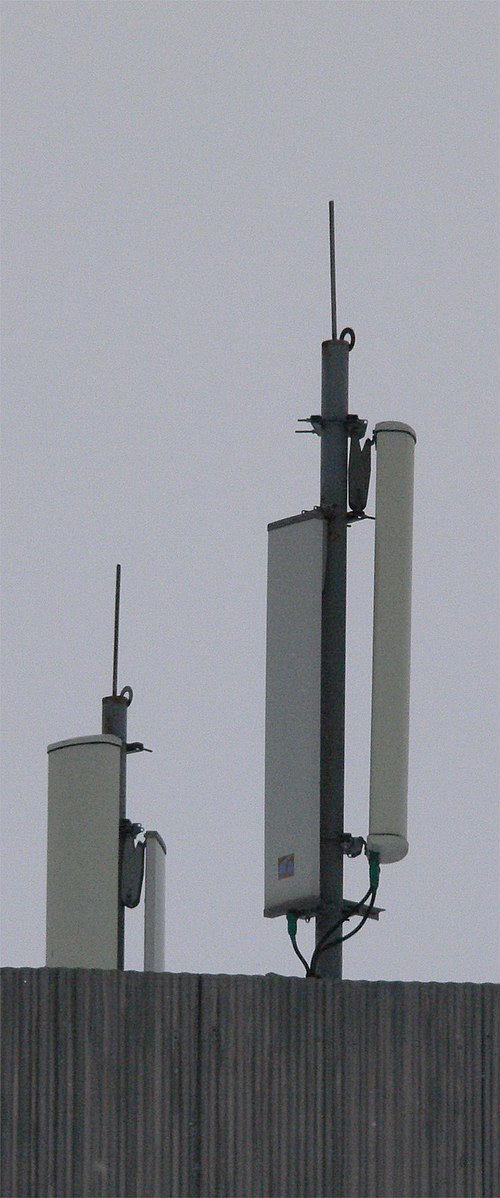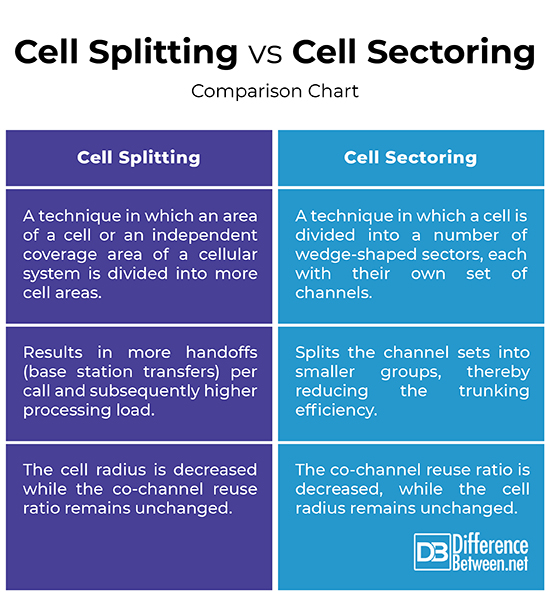Difference Between Cell Splitting and Cell Sectoring
Capacity of cellular systems has become a major concern for the designers simply because of its economic value and the increasing number of users. There are only so many users that can be incorporated in each cellular system without degrading the quality or performance of that specific cellular system. So, as the number of users increases, the traffic per unit time increases as well and as a result, it puts a burden on the allocated system, which gradually gets congested. The capacity of the channel decreases and new techniques will be required to provide extra channels. We take a look at two specific ways – Cell Splitting and Cell Sectoring – to increase the capacity of a cellular telephone system and try to understand the differences between the two to better understand how they work.

What is Cell Splitting?
As the number of users increases, so does the interference, thereby affecting the capacity of the cellular system. One immediate solution to this problem is to subdivide a cell into two or more smaller cells. This method is called cell splitting. So, it is a process by which an area of a cell or an independent coverage area of a cellular system is divided into more cell areas, while each cell has its own base station and a subsequent cutback in antenna height and transmitter power.
What it basically does is – it split the cells in areas of high usage into multiple smaller cells called microcells. So, it would require additional BSs to be established at the site of each new cell that has been installed in order to increase the capacity in congested areas. So, the purpose of cell splitting is to increase the capacity of a channel and improve the availability and reliability of cellular telephone network, providing an increase in the degree of frequency reuse.

What is Cell Sectoring?
One way to increase the capacity of a cellular network to make up for the increasing number of subscribers is to replace the omni-directional antenna at the base station with a number of directional antennas. This method is called cell sectoring. It is a very common technique used in macro cellular system to improve the performance against co-channel interference, wherein each cell is sub-divided into radial sectors with directional BS antennas.
In practical terms, a number of sectored antennas are mounted on a single microwave tower located at the center of the cell, and a subsequent number of antennas are installed to cover the full 360 degrees of the cell. The number of cells in a specific cluster is decreased in cell sectoring, and the separation between co-channels is decreased. So, cell sectoring basically refers to the method of decreasing co-channel interference to increase the cellular system capacity by using directional antennas for each sector within a cell.
Difference between Cell Splitting and Cell Sectoring
Technique
– While both the techniques are used to increase the capacity of a cellular telephone network system thereby providing service to the maximum number of subscribers, they work very differently. Cell splitting is a technique in which an area of a cell or an independent coverage area of a cellular system is divided into more cell areas. To cope with increased traffic, a cell is split into several smaller cells called microcells, with each cell having its own base station. Cell sectoring, on the other hand, is a process of dividing a cell into a number of wedge-shaped sectors, each with their own set of channels.
Co-Channel Reuse Ratio
– Cell splitting improves the capacity of the cellular network system by decreasing the cell radius (R) while keeping the co-channel reuse ratio (D/R ratio) unaffected (D is the co-channel separation distance), thereby increasing the number of channels per unit area. In cell sectoring, on the other hand, the number of cells in a specific cluster is decreased, so the co-channel reuse ratio is decreased, while the cell radius remains unchanged, unlike cell splitting.
Effects
– Cell splitting creates smaller cells; thus, the same number of channels can be used for small coverage areas and more users could be allocated. It increases the capacity of the channel, thereby providing an increase in the degree of frequency reuse. However, this results in more handoffs (base station transfers) per call and subsequently higher processing load. Cell sectoring improves co-channel interference but also splits the channel sets into smaller groups, thereby reducing the trunking efficiency. But the spectrum efficiency of the overall system is improved.
Cell Splitting vs Cell Sectoring: Comparison chart

Summary of Cell Splitting and Cell Sectoring
While the purpose of both cell splitting and cell sectoring is same –to increase the channel capacity and improve the reliability of a cellular telephone network – they work very differently. Cell splitting achieves a higher channel capacity by sub-dividing an area of a cell into several smaller cell areas, thereby providing an increase in the degree of frequency reuse. Cell sectoring, on the other hand, reduces co-channel interference by reducing the number of interferers that each cell is exposed to, whereby each cell is divided into radial sectors with directional BS antennas. Practically speaking, the effect of an omni-directional antenna can be achieved by installing a number of directional antennas to cover the whole 360 degrees.
- Difference Between Caucus and Primary - June 18, 2024
- Difference Between PPO and POS - May 30, 2024
- Difference Between RFID and NFC - May 28, 2024
Search DifferenceBetween.net :
Leave a Response
References :
[0]Tomasi, Wayne. Electronic Communications System: Fundamentals Through Advanced (Fifth Edition). New Delhi, India: Pearson Education India, 2009. Print
[1]Balanis, Constantine A. and Panayiotis I. Ioannides. Introduction to Smart Antennas. San Rafael, California: Morgan & Claypool Publishers, 2007. Print
[2]Agrawal, Dharma P. and Qing-An Zeng. Introduction to Wireless and Mobile Systems. Massachusetts, United States: Cengage, 2015. Print
[3]Stüber, Gordon L. Principles of Mobile Communication. Berlin, Germany: Springer Science & Business Media, 2013. Print
[4]Terplan, Kornel and Patricia A. Morreale. The Telecommunications Handbook. Boca Raton, Florida: CRC Press, 2018. Print
[5]Image credit: https://commons.wikimedia.org/wiki/File:Sector_antennas_on_mast.jpg
[6]Image credit: https://snappygoat.com/b/68420220e73b9d51d4a702e9b5d7cb4a77071290
